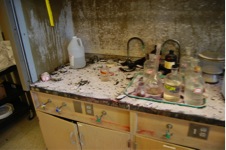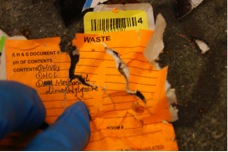Failure to Segregate Waste Streams Mixes Nitric Acid and Organic Solvent, Causes Waste Bottle to Explode From Pressure Buildup; Written Procedures Did Not Reflect Current Procedures
What happened?
On February 2, 2015 in a chemistry teaching lab three undergraduate students and a graduate teaching assistant (TA) were injured and required medical attention when a glass waste bottle exploded. The bottle exploded while a student tried opening the container to add waste during the course of the planned experiment. The lab was evacuated and the Texas Tech Police Department and the Lubbock Fire Department responded to secure the lab and transport the injured to the hospital.
All students and personnel were wearing appropriate personal protective equipment including lab coats, safety goggles and gloves.

Area in fume hood where waste was stored.

Waste label indicating incompatible waste mixture..
What was the cause?
On January 30, 2015, during a preparation laboratory to instruct the TA's for the coming week they were provided written instructions for the lab procedures that did not exclude a step using a Nitric Acid wash. This step was removed from the procedure in 2011 but the written instructions were never changed to reflect this. This waste material was disposed of into a waste bottle containing Methanol and Dimethylglyoxime and the waste bottle was capped at the end of the experiment. Over the weekend the reaction in the bottle built up pressure until the teaching lab where student handled the bottle and the bottle integrity failed.
What caused the incident?
- Incompatible wastes were mixed together. An inorganic acid and an organic solvent.
- Procedures were not changed to reflect updates. The Nitric Acid step was removed but this was not reflected in the written procedures.
What corrective actions were taken?
When fire and police personnel released the lab, Environmental Health and Safety (EH&S) staff conducted a cleanup and investigation and released the lab the next day. The investigation included three recommendations which are provided below:
- The University should investigate the use of waste containers that will allow pressure
release and/or containers that have a smaller chance of failure. EH&S will be providing pressure relief caps to waste storage bottles that contain
inorganic acid wastes.
- Faculty, instructors and TA's should communicate unique safety concerns at the beginning
of teaching labs prior to any experiments. The safety concerns should reflect the
hazards posed by that experiment. This is a recommendation to the Colleges and the Departments to produce a more observant
student group and more effectively communicate hazards.
- Responsible individuals over teaching labs should revise their teaching procedures regularly and review for possible hazards that can be eliminated. Any additions or deletions should be reflected in handouts provided. This is a recommendation the Colleges and the Departments to reflect a safety review of the curriculum that should be reflected in the course syllabus.
EH&S staff met with the department safety committee and faculty member to convey these recommendations and provide an engineering control in the form of pressure relief caps for waste containers of inorganic acid,
How can we prevent incidents like this?
- Conduct proper waste segregation as waste is added. INORGANIC ACIDS AND ORGANIC SOLVENTS SHOULD NOT BE MIXED.
- Review all written procedure to make sure the they reflect the current understood procedure.
Resources
Environmental Health & Safety
-
Address
Texas Tech University, 407 Flint Ave, Lubbock, TX 79409 (Mail Stop 1090) -
Phone
806.742.3876 -
Email
safety@ttu.edu
